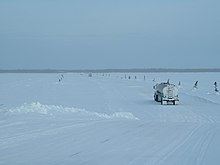Winter road


A winter road is a seasonal road only usable during the winter, i.e. it has to be re-built every year. This road typically runs over land and over frozen lakes, rivers, swamps, and sea ice.[1][2] Segments of a winter road that cross an expanse of floating ice are also referred to as an ice road or an ice bridge.[1]
The foundations underlying over-land segments is most often native soil or muskeg frozen to a given depth, and locally, bedrock. These surfaces may either be bare or are overlain, as is most commonly the case, with a snow cover. Over-ice segments of winter roads are often referred to as ice crossings, ice bridges or, simply, ice roads.[3] The weight of the vehicle is supported by the buoyancy of the floating ice and by its resistance to flexure. Where a winter road is built mostly on floating ice, the occasional land crossings are called "portages" - the Tibbitt to Contwoyto Winter Road is an example.
Winter roads facilitate transportation during the winter to, from and within isolated areas in the North where there are no permanent (also called 'all-weather' or 'all-season') roads.[4] They enable supplies (e.g. food, fuel, construction material) to be brought into communities in these areas.[5] The only other alternative, providing there is a small airstrip nearby, would be to rely on air transportation. However, this can be prohibitively costly, especially for bulk material.[5][6] In some areas, climate change is observed to affect winter roads, notably by contributing to a significant reduction in their operational lifespan.[6][7]
See also
References
- ^ a b Proskin et al, 2011. Guidelines for the Construction and Operation of Winter Roads, Transportation Association of Canada.
- IHSA, 2014. Best practices for building and working safely on ice covers in Ontario, Mississauga, Ontario, 43 p.
- NorthWest Territories Transportation, 2015. Guidelines for safe ice construction, Yellowknife, NWT, Canada, 44 p. - ^ Spencer, P.A., Strandberg, A.G. and Maddock, W.A., 2008. Ice and toundra road design for module transport, Proceedings of the 8th International Conference on Ships and Marine Structures in Cold Regions (ICETECH), Banff.
- ^ Michel, B., Drouin, M., Lefebvre, L.M., Rosenberg, P. and Murray, R., 1974. Ice bridges in the James Project. Canadian Geotechnical Journal, 11: 599-619.
- Barrette, P.D., 2015, Overview of ice roads in Canada: Design, usage and climate change adaptation, OCRE-TR-2015-011. National Research Council of Canada, Ottawa, 51 pp. - ^ Barrette, Paul D.; Hori, Yukari; Kim, Amy M. (2022-07-14). "The Canadian winter road infrastructure in a warming climate: Toward resiliency assessment and resource prioritization". Sustainable and Resilient Infrastructure. 7 (6): 842–860. doi:10.1080/23789689.2022.2094124. ISSN 2378-9689. S2CID 250574906.
- ^ a b Kuryk, D. and Domaratzki, M., 1999. Construction and maintenance of winter roads in Manitoba, Proceedings of the 10th Workshop of the Committee on River Ice Processes and the Environment (CRIPE), Winnipeg, pp. 265-275.
- ^ a b McGregor, R.V., Hassan, M. and Hayley, D., 2008. Climate change impacts and adaptation: Case studies of roads in Northern Canada, Proceedings of the Annual Conference of the Transportation Association of Canada. Transportation Association of Canada, Toronto.
- ^ Rawlings, M., Bianchi, R. and Douglas, R.A., 2009. Winter roads and ice bridges: Anomalies in their records of seasonal usage and what we can learn from them, Proceedings of the Annual Conference of the Transportation Association of Canada. Transportation Association of Canada, Vancouver.
Sources
- Proskin, et al, . (2011). Guidelines for the Construction and Operation of Winter Roads. Transportation Association of Canada. Retrieved 2020-12-01.
{cite book}: CS1 maint: multiple names: authors list (link) - Best Practices for Building and Working Safely on Ice Covers in Ontario (PDF). Infrastructure Health & Safety Association (IHSA). 2014. Retrieved 2020-12-01.
- GUIDELINES FOR SAFE ICE CONSTRUCTION (PDF). Department of Transportation of the Government of the Northwest Territories. 2015. Retrieved 2020-12-01.
- "ICETECH 2008 July 20-23, 2008 Banff, Canada Program and Conference Guide" (PDF). ICETECH 2016 Conference. p. 7. Retrieved 2020-12-01.
#167 Ice and Tundra Road Design for Module Transport, P. Spencer, A. Strandberg and W. Maddock
- Michel, B.; Drouin, M.; Lefebvre, L.M.; Rosenberg, P.; Murray, R. (1974). "Ice bridges in the James Project". Canadian Geotechnical Journal. 11: 599–619. doi:10.1139/t74-060.
- Barrette, PD (2015). A Review of Guidelines on Ice Roads in Canada: Determination of Bearing Capacity. Transportation Association of Canada (TAC). Retrieved 2020-12-01.
- Kuryk, D.; Domaratzki, M. (1999). "Construction and Maintenance of Winter Roads in Manitoba". Proceedings of the 10th Workshop on the Hydraulics of Ice Covered Rivers. 10. Committee on River Ice Processes and the Environment: 265–275. Retrieved 2020-12-01.
- Mcgregor, R.; Hassan, M.; Hayley, D. (2008). Climate Change Impacts and Adaptation: Case Studies of Roads in Northern Canada (PDF). Annual Conference of the Transportation Association of Canada. Retrieved 2020-12-01.
- Rawlings, Martin; Bianchi, Ron; Douglas, Ronald A. (2009). Winter roads and ice bridges: anomalies in their records of seasonal usage and what we can learn from them. Integrated Committee on Climate Change (Climate Change Task Force). Retrieved 2020-12-01.